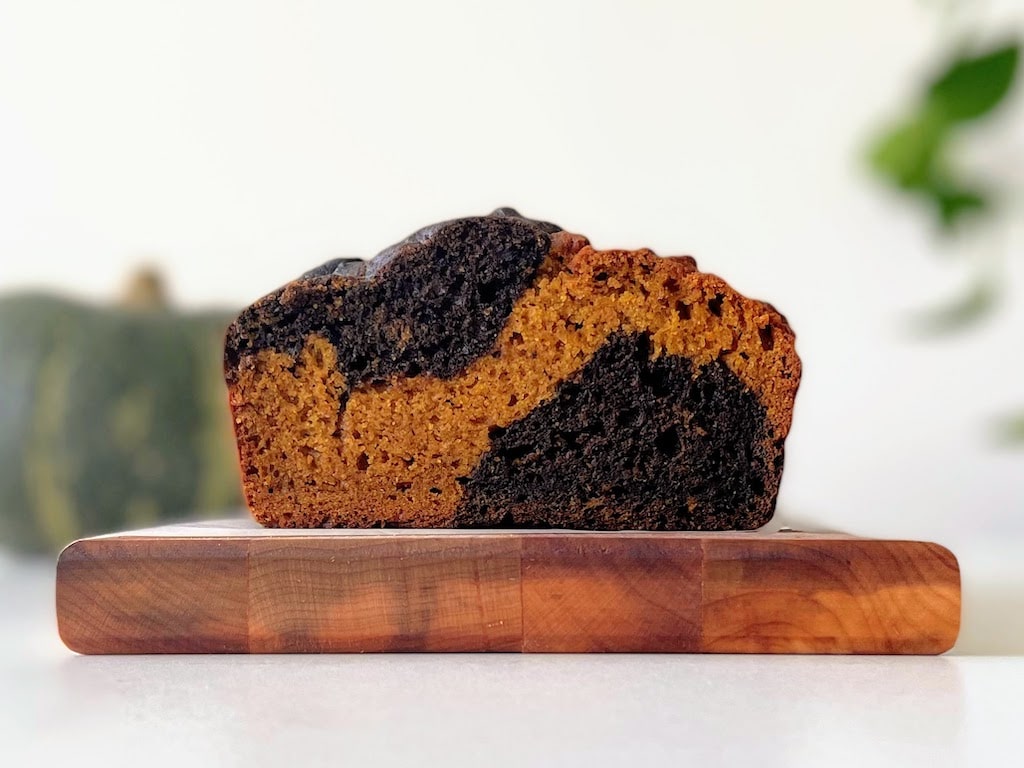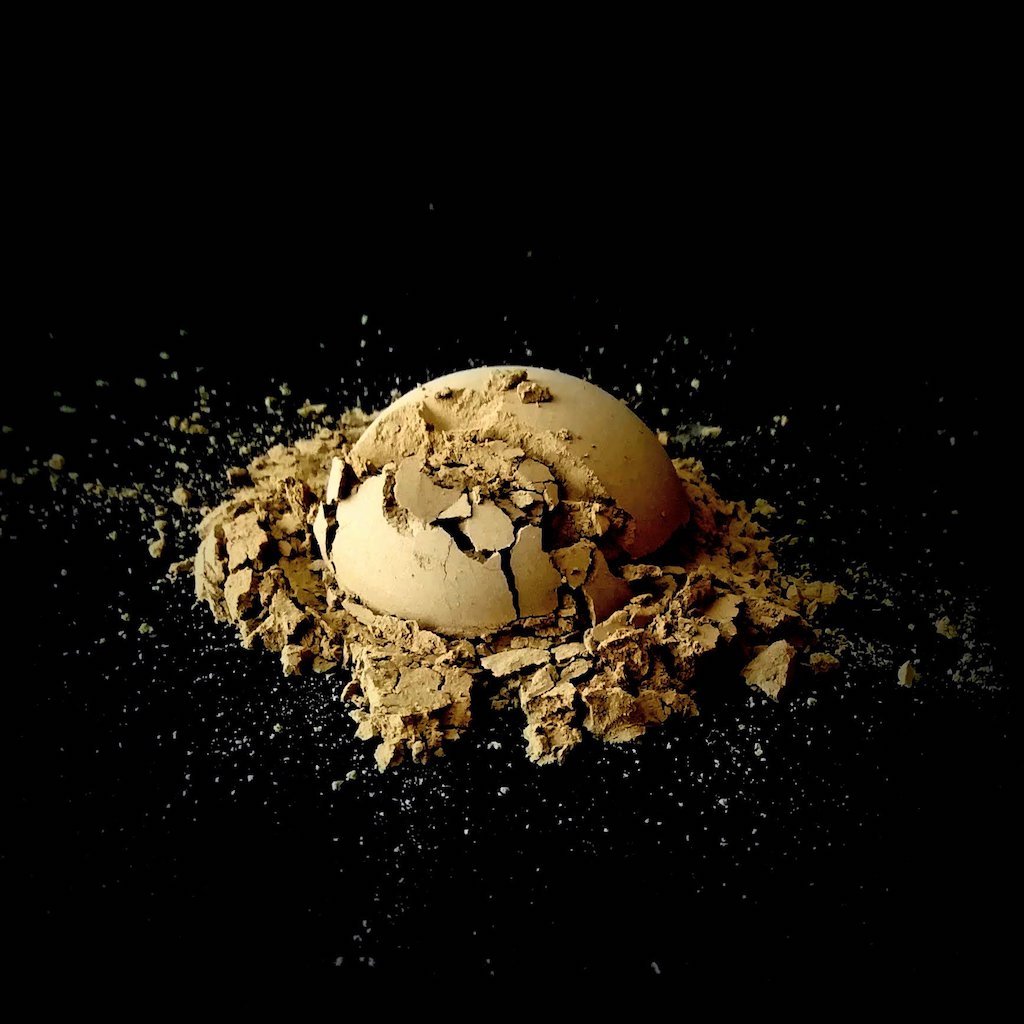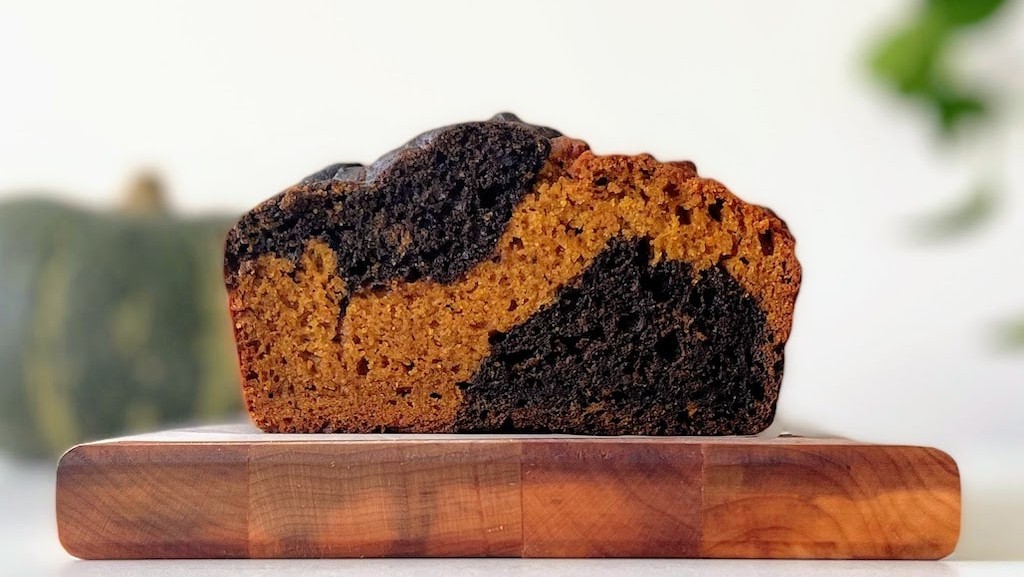
This delicious Marbled Japanese Pumpkin Bread gets its stunning swirls from the vivid kabocha squash and chocolatey Hojicha Powder.
What is a Japanese pumpkin
Japanese pumpkin refers to kabocha, a type of winter squash most commonly enjoyed in Japan in vegetable tempura or korokke (croquettes). It has a dark green exterior with lighter green stripes and an orange interior. The kabocha has a sweet earthy taste with notes of chestnuts and sweet potatoes that pair perfectly with hojicha.
How to make a Marbled Japanese Pumpkin Bread
Marbled Japanese Pumpkin Bread is a quick bread made by mixing the dry ingredients and wet ingredients separately, with the addition of flavorful pumpkin purée into the wet ingredients. The dry and wet ingredients are then briefly stirred together until just combined. The batter is divided in half, and Hojicha Powder is added to only one of the halves. The plain and hojicha batter are carefully marbled in a loaf pan, and baked to create a beautiful and moist pumpkin bread.
What does the hojicha swirl taste like
The hojicha swirl gets its deep color and taste from Hojicha Powder, a roasted green tea originating in Kyoto, Japan. The resulting taste of the hojicha swirl is toasty, nutty, earthy, and chocolatey with both the hojicha and pumpkin flavors coming through.
Hojicha Powder is the easiest way to add roasted green tea flavor to baked goods, and be used as a substitute to cocoa powder to create delightful marbled patterns in other loaf recipes.
How to prepare Japanese pumpkin purée
Since the Japanese pumpkin has a tough exterior, we prefer to first soften it. This can be done by deeply piercing holes in the kabocha, and roasting it at 400°F (200°C) until just tender. Then the kabocha can be easily cut first in half to scoop out the seeds, and then into wedges. The Japanese pumpkin can then be prepared by steaming it until well cooked, peeling the skin, and blending until smooth to make the purée. If you prefer to mash it by hand, be sure to pass it through a fine-mesh sieve to ensure a smooth and even consistency.
Can you substitute the Japanese pumpkin
The Japanese pumpkin can be easily substituted with other winter squash varieties you may have on hand. A few alternatives to the kabocha squash that may taste best are buttercup, butternut, acorn, and the classic orange pumpkins typically used for making pumpkin pie on Thanksgiving or carving jack-o'-lantern on Halloween.
Since kabocha is sweeter than other varieties, you may want to add approximately 1/4 cup of additional sugar for a sweeter pumpkin bread.
If using a store-bought canned pumpkin, make sure it is pure pumpkin purée and not flavored pumpkin pie filling as this will alter the flavor and texture of the loaf.
The squash variety and its cooking method will also impact the water content of the purée and in turn the bake time. Insert a cake tester or knife all the way into the bottom of the loaf after 75 minutes, and if it comes out with wet batter then the loaf is undercooked and needs more time in the oven. Keep in mind that your loaf may take longer to bake, and loosely tent the pan with aluminum foil if the top begins to over brown before the center or bottom are cooked through. The Marbled Japanese Pumpkin Bread is ready once the cake tester or knife comes out clean or with only a few moist crumbs.
How to create the marble effect
If this is your first time creating a marble effect on your baked goods, know that it is much easier than it looks and absolutely worth the extra steps. The marble effect creates a visually appealing loaf, and also gives it a wonderful contrast of flavors.
Creating a perfectly marbled pumpkin bread starts by adding alternating dollops of plain and hojicha batter. We like to envision a 2x3 grid, and add roughly equal amounts of batter in two layers for the best results. At this point, it should look similar to a checkerboard.
Then a chopstick or skewer is inserted into the batter in one corner of the pan, while making sure it nearly reaches the bottom. We then like to swirl the batter in one large 8 figure, and two smaller 8 figures in a continuous motion. Avoid the temptation to overdo it, as only a few swirls are needed to create a gorgeous marble effect.
Ready to get baking? Here's the recipe for a Marbled Japanese Pumpkin Bread perfect for impressing friends at brunch, or enjoying on a cozy autumn afternoon with a warm cup of hojicha.
Ingredients
- 1 teaspoon coconut oil (for greasing the pan)
- 2 cups all purpose flour
- ¾ teaspoon baking soda
- ½ teaspoon salt
- 1 teaspoon cinnamon
- ¼ teaspoon ginger
- 2 tablespoons Hojicha Powder
- 3 tablespoons water
- ¼ cup granulated sugar
- ¼ cup brown sugar
- ½ cup neutral oil (we used sunflower oil)
- 1 tablespoon rice vinegar
- ¼ cup plain unsweetened yogurt (we used dairy-free coconut yogurt)
- 1 ¼ cup kabocha puree
- ¼ cup maple syrup
- Optional: cloves, nutmeg, or pumpkin spice mix
Directions
- Preheat the oven to 350° F (180° C).
- Grease a 9x5 loaf pan with 1 teaspoon of coconut oil.
- Line the pan with parchment paper by cutting a piece of parchment that fits the length of the pan with an extra inch or two for overhang on each of the longer sides.
- Press the parchment paper down to lay it flat against the bottom and sides of the pan, and lightly grease it with the coconut oil.
- In a medium bowl, stir together 2 cups of flour, ¾ teaspoon of baking soda, ½ teaspoon of salt, 1 teaspoon of cinnamon, and ¼ teaspoon of ginger. Set aside.
- Into a small bowl, add 2 tablespoons of Hojicha Powder and 2 tablespoons of cold or room temperature water. Stir together, and then use the back of a spoon to create a smooth and thick paste.
- Add the remaining 1 tablespoon of water to thin out the hojicha mixture. Set aside.
- Into a large bowl, add ¼ cup of granulated sugar, ¼ cup of brown sugar, ½ cup of oil, 1 tablespoon of rice vinegar, ¼ cup of yogurt, 1 ¼ cup of kabocha puree, and ¼ cup of maple syrup. Whisk together until well incorporated.
- Add the dry ingredients into the wet ingredients, and reserve the medium bowl.
- Fold the batter until barely combined, then divide in two.
- Transfer half of the batter into the medium bowl, and fold again until there are no large pockets of flour.
- Add the hojicha mixture into the large bowl, and fold together until combined. It’s better to have a few streaks remaining than to over mix.
- Add alternating dollops of the plain and hojicha batter into the pan.
- Insert a chopstick or skewer almost to the bottom of the pan, and swirl the batter in figure 8 motions to create the marble effect.
- Place the pan into the oven, and start checking for doneness after 60 minutes. Loosely tent with foil if the top begins to over brown.
- The Marbled Japanese Pumpkin Bread is ready when cracks appear on the surface, and a cake tester or knife comes out with a few crumbs.
- When done, remove from the oven and cool in the pan for 10 minutes.
- Remove the pumpkin bread from the pan by using a spatula to gently release the sides, and then holding onto the overhanging parchment to carefully lift onto a cooling rack.
- Let cool fully on the rack before slicing and serving your flavorful Marbled Japanese Pumpkin Bread.



